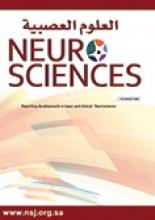To the Editor
We have read with interest the article by Zhao et al1 on a 21 years-old male with Kearns-Sayre syndrome (KSS) due to the novel variant c.170G>C in SLC25A4 which led to depletion of the mitochondrial DNA (mtDNA) to 18.7%.1 The patient presented phenotypically with progressive dysarthria starting from age 13, cerebellar atrophy from age 17, and ptosis and ophthalmoparesis from age 19.1 The study is attractive but raises concerns that should be discussed.
We disagree with the diagnosis KSS. Kearns-Sayre syndrome is diagnosed based on the phenotype. The prerequisite for the diagnosis is the presence of the 3 main clinical features (progressive external ophthalmoplegia, onset <20y, pigmentary retinopathy) and at least one of the features cerebrospinal fluid (CSF) protein >100mg/dl, cardiac conduction defects, or cerebellar dysfunction.2 Interestingly, the patient did not present with pigmentary retinopathy, or heart block. Additional phenotypic features include hypoacusis, PNS involvement, short stature, growth hormone deficiency, lactic acidosis, facial dysmorphism, hypoparathyroidism, emesis, aortic insufficiency, subaortic septum hypertrophy, right bundle-branch block, and white matter lesions.2 None of these additional features were present in the index patient. It was not possible to assess whether the cerebrospinal fluid (CSF) protein was elevated because reference limits were not given in Table 2.1 Since the patient did not have all three central phenotypic characteristics, and manifested additionally only with cerebellar dysfunction, the diagnosis KSS remains speculative. Since SLC24A4 variants usually cause mitochondrial depletion syndrome (MDS) and KSS is usually due to single mtDNA deletions, single mtDNA duplications, or mtDNA point mutations, the index patient should be diagnosed with MDS, with a KSS-like phenotpye rather than as KSS. Mitochondrial depletion syndrome due to SLC25A4 variants phenotypically manifests with epilepsy, cognitive dysfunction, encephalopathy, cerebral atrophy, white matter lesions, cataract, cardiomyopathy, arterial hypertension, myopathy, or scoliosis.3 Which of these manifestations were found in the index patient?
We disagree with the statement in the abstract that KSS is a subtype of progressive external ophthalmoplegia (PEO).1 Though PEO may evolve into KSS over time,4 both disorders are distinct syndromic mitochondrial disorders (MIDs).
A shortcoming of the study is that the mtDNA was not sequenced to know if there were single or multiple mtDNA deletions or an mtDNA point mutation.
There is a discrepancy between case description and discussion. In the first paragraph of the discussion the patient is described with diffuse, retinal depigmentation, which is not described in the case description or in Table 1. This discrepancy should be solved.
The wording in the abstract “only when the proportion of mutations in the SLC25A4 gene reach a certain degree” is not comprehensible and the meaning should be clarified.
We do not agree with the statement that cerebellar atrophy has not been previously reported.1 Cerebellar atrophy has been repeatedly reported5,6 and may be even asymmetric as in the index patient.
Overall, the interesting study has some limitations and inconsistencies that call the results and their interpretation into question. Addressing these limitations could further strengthen and reinforce the statement of the study. SLC25A4 variants cause MDS which may manifest with a KSS-like phenotype. Kearns-Sayre syndrome is a mitochondrial syndrome due to single mtDNA deletions or mtDNA duplications.
Reply from the Author
No reply received from the author.
- Copyright: © Neurosciences
Neurosciences is an Open Access journal and articles published are distributed under the terms of the Creative Commons Attribution-NonCommercial License (CC BY-NC). Readers may copy, distribute, and display the work for non-commercial purposes with the proper citation of the original work.






